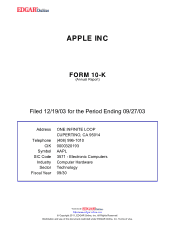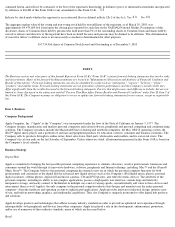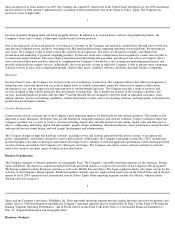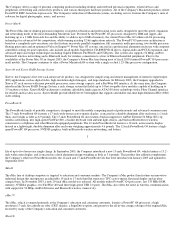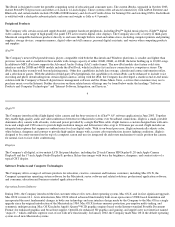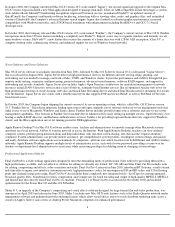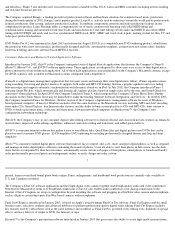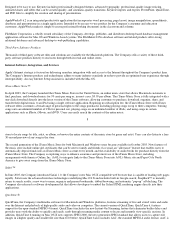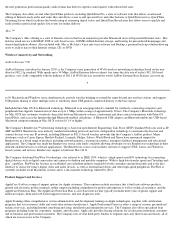Apple 2003 Annual Report Download - page 11
Download and view the complete annual report
Please find page 11 of the 2003 Apple annual report below. You can navigate through the pages in the report by either clicking on the pages listed below, or by using the keyword search tool below to find specific information within the annual report.
Specialized Education Products and Services
The Company offers a variety of unique services and products to its education customers, including a separate online store for education
customers offering special education price lists and promotions; special financing programs for K-12 and higher education students, faculty,
and staff; a special edition of its productivity software suite, AppleWorks, that is cross platform for both Macintosh and Windows computers;
the iBook Wireless Mobile Lab that allows teachers and students to share iBook computers, a printer, and a wireless network/Internet
connection stored on a cart for mobility between classrooms; and
10
three special Digital Media Studio solutions designed for education, including one that is integrated into a mobile cart. Additionally, Apple
Professional Services offers a range of technical services to education customers.
In 2001, Apple acquired PowerSchool Inc., a privately held provider of web-based student information systems for K-12 schools and school
districts. PowerSchool ® software products give school administrators and teachers the ability to easily and cost-effectively manage student
records and give parents real-
time access to track their children's performance via the Internet. PowerSchool offers the option of remote hosting
with an application service provider model.
Markets and Distribution
The Company's customers are primarily in the education, creative, consumer, and business markets. Certain customers are attracted to
Macintosh computers for a variety of reasons, including the reduced amount of training resulting from the Macintosh computer's intuitive ease
of use, advanced graphics capabilities, industrial design features of the Company's hardware products, and ability of Macintosh computers to
network and communicate with other computer systems and environments. Apple personal computers were first introduced to education
customers in the late 1970s. Over 18% of the Company's net sales in 2003 were to education customers in the United States, including sales to
elementary and secondary schools and college and university customers.
The Company distributes its products through wholesalers, resellers, national and regional retailers and cataloguers. No individual customer
accounted for more than 10% of net sales in 2003, 2002 or 2001. The Company also sells many of its products and resells certain third-party
products in most of its major markets directly to education customers, consumers, businesses, and certain resellers through its retail stores in
the United States, or through one of its online stores around the world. Total direct and indirect sales attributable to the Company's online stores
totaled approximately $2.9 billion, $2.4 billion, and $2.0 billion for fiscal years 2003, 2002 and 2001, respectively.
Competition
The Company is confronted by aggressive competition in all areas of its business. The market for the design, manufacture, and sale of personal
computers and related software and peripheral products is highly competitive. This market continues to be characterized by rapid technological
advances in both hardware and software development, which have substantially increased the capabilities and applications of these products,
and have resulted in the frequent introduction of new products and significant price, feature, and performance competition. Over the past
several years, price competition in the market for personal computers has been particularly intense. The Company's competitors who sell
personal computers based on other operating systems have aggressively cut prices and lowered their product margins to gain or maintain
market share. The Company's results of operations and financial condition have been, and in the future may continue to be, adversely affected
by these and other industry-wide downward pressures on gross margins.
The principal competitive factors in the market for personal computers include relative price/performance, product quality and reliability,
design innovation, availability of software, product features, marketing and distribution capability, service and support, availability of hardware
peripherals, and corporate reputation. Further, as the personal computer industry and its customers place more reliance on the Internet, an
increasing number of Internet devices that are smaller, simpler, and less expensive than traditional personal computers may compete for market
share with the Company's existing products.
The Company is currently taking and will continue to take steps to respond to the competitive pressures being placed on its personal computer
sales as a result of innovations in competing platforms. The Company's future operating results and financial condition are substantially
dependent on its ability to continue to develop improvements to the Macintosh platform in order to maintain perceived functional and design
advantages over competing platforms.
11
The Company's initial success with the development of an end-to-end music offering, which includes the iTunes digital music management
software, iTunes Music Store and iPod digital music player, has already encouraged significant competition in this area from other companies,

